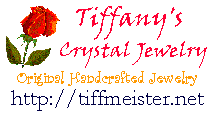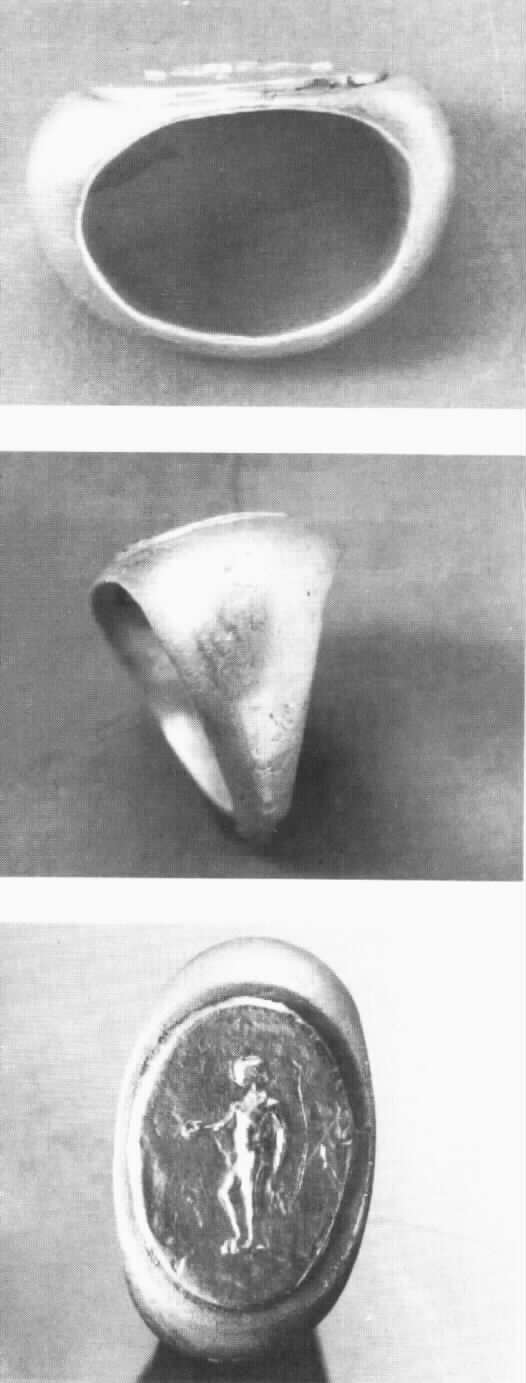
This section is to help with what rings styles were popular at the end of the Roman Empire. Styles blended with many conquered territories. The rings sold through my site are from Eastern Europe, and have some Eastern Celtic designs with Roman Symmetry of taste in style.
 pg. 184, Roman Jewellrey Dated 2-3rd century | This is an example of a basic Roman Ring design. Romans loved ellipsoid shields with wide thick shoulders. Hoops were also ellipsoids, with some simple design on the shield. Sometimes a stone is inserted with a intaglio relief. Rings were made of gold, as in this example, or sometimes silver dipped bronze. Bronze, of course, was the most popular, since it resembles gold so much. Bronze is a alloy of tin and copper. However, in Roman times, there was no standard alloy. Jewelers all would vary with their mixtures of bronze. | |
 pg. 182, Roman Jewellry Classic Roman Snake ring in good condition. 300 AD | Snakes were the rage of Roman Jewellry. Often, they were the two heads of a snake joining to the center, a copy from Greek culture. Snake heads vary in design, and some of the markings are rubbed away that would mark eyes and designs on the hood. Often what is left is just the shape of the head. |  pg. 199, Roman Jewellry Silver snake ring where the ruined shoulders are of a snake design. Incised circles make up the eyes with an X on the hood. 300 AD |
| Hatch designs appear a lot in Roman Rings. The conquered Celtic tribes either contributed with their designers, or Roman Jewellers borrowed and included them in their designs. Of course, both things probably happened. Roman Jewellers would borrow designs to please new vanquished customers, and vica versa. Celtic Jewellers would start designing rings for their Roman customers including Celtic designs. Hatching was used a lot in Celtic Art Design to fill in spaces. It is seen in some Roman rings as a design on many shields. Sometimes, they could have had symbolized lightning bolts or other items in life. The research is continuing in this area. |  pg. 193, Roman Jewellrey Silver Roman Ring with oval hoop and thin band. Sholders are decorated with 3 vertical hatch marks. 300 AD |
The hatch design appears on a lot of Soldiers rings and rings of family members of Roman Soldiers. The mean might be of the famous lightning bolts of the Roman Army. There are a lot of these designs coming from Eastern Europe. Since most are coming from battle fields, it's not surprising. Roman soldiers buried rings before battle, hoping of course to return. Since most Roman citizens wore rings on all fingers and midfinger to show wealth, that is a lot of rings pers soldier. And if the poor unfortunate fellow did not return? They have remained there for the centuries to be found later by Eastern European farmers with metal detectors.
Hatching is also a trait of Celtic design and later Thracian design. Handed down from their Celtic ancestors, the Thracians used hatching to fill in shapes in their designs as well as the use of the concentric circle. Many of the rings that I acquire from my antique dealer resources get their rings from Thracia and sometimes Moesia.
| Concentric circles appear a lot in Roman jewelry. First appearing in Eastern Celtic Art, either it was copied into Roman Fashion, or created from elsewhere. More likely it was absorbed as were other designs from other cultures, such as from Greece in the Hellenistic Period. This ring has two concentric circles. It is made of Bronze, and has hatching on the shoulders. It is dated around 200 AD. |  pg. 199, Roman Jewellrey Found in Pantalin Territory near Rodomir, Bulgaria. |
|
 pg. 40, Rings Through the Ages Conjoined Celtic Spiral Bronze Ring Currently in the Louvre, Paris. | Celtic designs show up a lot in Ancient Roman rings from Eastern Europe probably due to the Eastern Celtic Tribal infleunce. These rings show basic Celtic designs that show up in Roman rings. The Celtic spiral, meaning often the infinate, is actually making a comeback in popularity in Contempoary design. Bands with dots and lines also can be seen in Roman rings. Some Byzantine designs also contain this dotting and line design. |  pg. 42, Rings Through the Ages Gold Celtic Rings currently in the Danish National Museum. From Celtic Royal Burial. Dated 150-200 AD. |
This section is in constant research. New research information is added regularly when I have time from my day job of teaching. If you have any questions, please email me below. I'm only able to put a thumbnail scratch of what I've been finding out, just to help you get started. Plus, each ring is so individual, different research may apply to each one.
NOTE: It has come to my attention from the antique dealers I buy through that many of the Roman Artifacts, esp. dated 100-300AD, have been now limited and highly taxed for import into our country(USA). This is mostly due to the flood of these dated artifacts into the antique market and Ebay. All I can say is that prices might be going up some on these items, but I will try to keep them low and reasonable since I enjoy restoring the history and beauty these items process. I also think that they need to be enjoyed and worn by the common people again since that is what they were originally made for.
As more news comes of this, I will let you know. But then, it's not that I didn't expect it. I have been selling Roman Artifacts in a new jewelry form or restored for almost a year now. It was bound to happen with all the copycat sellers now on Ebay. All I can say is that you check on who you buy from. See if they know what they are talking about. Legitimate sellers on Ebay that sell real artifacts(often bought and resold by many other dealers on Ebay) are Silenos Antiques and Antiquities, Nemesis, and Hail-Cesare. I have bought from them from time to time, and they have very unique and authentic pieces. IF you have any questions, please email me through my website.
Back to the Ancient Roman Ring Research Mainsite
Back to the Ancient Roman History Page
Back to the Roman Map & Ring Terms Page
Back to the Tiffany's Crystal Jewelry Homesite
This page hosted by
![]() Get
your own Free Home Page
Get
your own Free Home Page